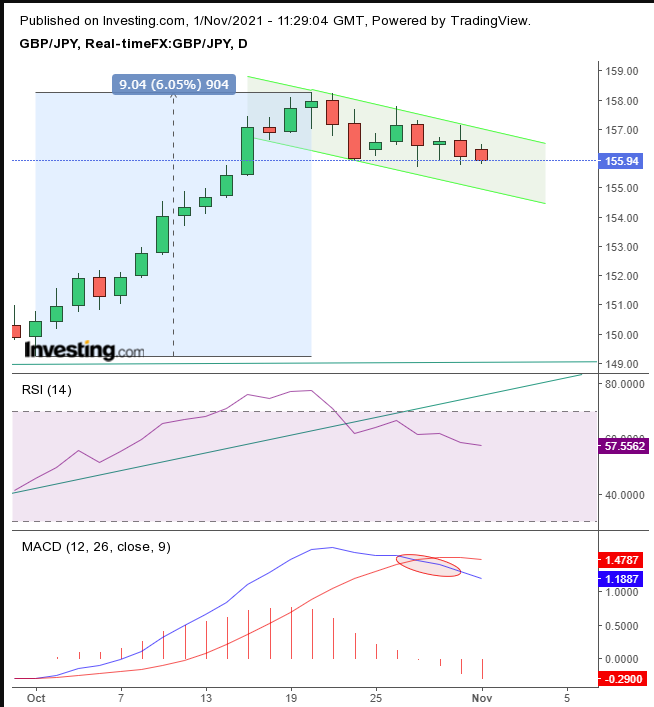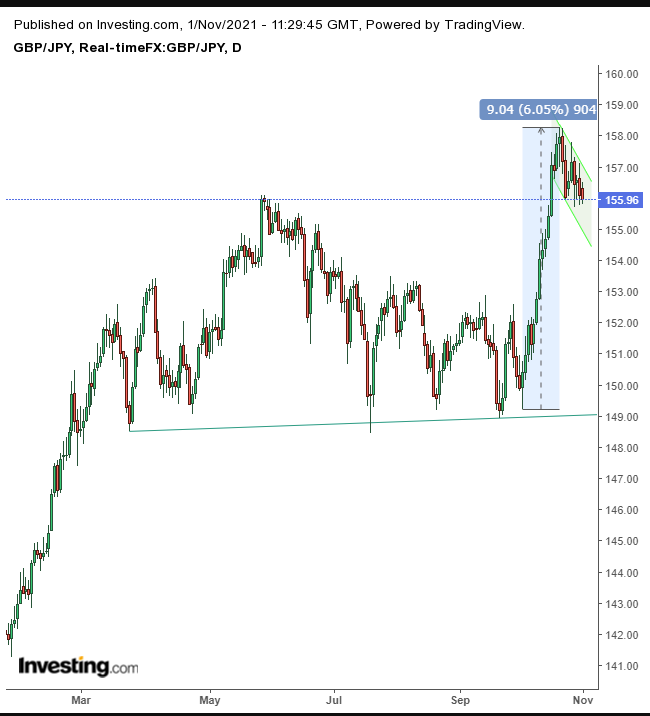Earlier this morning, the Japanese yen lost 0.2% against the dollar after the surprise results of the Asian country's parliamentary election, held on Sunday, showed that Prime Minister Fumio Kishida and his Liberal Democratic Party were able to hold on to their strong majority. One result of the election: markets are now expecting Japanese stimulus measures will easily pass in the wake of the LDP's victory.
On the other end of the policy spectrum, the Bank of England is seen to be about to take a leadership role in the path to tightening. BoE chief Andrew Bailey warned a few weeks ago that the UK's central bank would have to control inflation, increasing expectations for a rate hike.
That policy divergence, coincidentally (or perhaps not) is also currently playing out via the sterling/yen currency pair.

The GBP/JPY surged 6%, rising for 12 out of 14 days. That kind of advance could leave many experienced bulls out of breath, which is when the pair stopped its break-neck climb, as traders locked in profits. At least that's the presumption for what happend with this extraordinary sharp advance, followed by congestion with a downward bias.
The 'flag pole' is the straight line up while the declining congestion is the 'falling flag.' It moves lower as bulls close out long positions, which both reduces demand as well as increases supply.
However, it doesn't look like the trend has actually reversed. The move lower has been small and highly crowded. This signals there's a willing participant on the other side of each transaction, demonstrating continued demand.
After buyers exit and supply dries up, bulls will have to increase their bids beyond the scope of the flag to find new, willing, but more demanding sellers.
At the same time, that upside breakout will signal to the earlier bulls that their hunch on the pair wasn't wrong. As such, they'd pour right back in, pushing the GBP/JPY up further.
Note how the RSI's uptrend fizzled, a leading indicator the pair could be heading lower. The MACD's short MA crossed below the long MA, demonstrating weakening price averages.
The longer view provides additional context for the move.

Bulls needed the energy of the flagpole to blow out a H&S top. The flag then found support above the would-be reversal pattern.
In other words, traders used the flag as a market slingshot to get through the bearish top. Looking at this another way, a sudden reversal of expectations flipped the market and that forceful repositioning created that momentum needed to form the flagpole.
The upside breakout would signal another such move from the point of the breakout.
Trading Strategies
Conservative traders should wait for the upside breakout, followed by a return move that finds support.
Moderate traders would wait for the same movement, the penetration and the pullback, but for a better entry, if not confirmation.
Aggressive traders could buy now on the presumed support of the failed H&S top and the flag characteristics of the recent rally. However, they should consider entering only if they accept the higher risk that comes with the higher reward when moving before other traders. A coherent trade plan is critical. Here's an example:
Trade Sample - Aggressive Long Position
- Entry: 156.00
- Stop-Loss: 155.50
- Risk: 50 pips
- Target: 160.00
- Reward: 400 pips
- Risk:Reward Ratio: 1:8
Author's Note: We are not in the fortune-telling business. We apply statistic-based trading models, which, if handled consistently, will increase the odds of positive results if you don't know how to customize a trading plan. Use our samples for educational purposes, not to profit. Otherwise, you'll neither learn nor profit. Guaranteed, and there's no money back.
